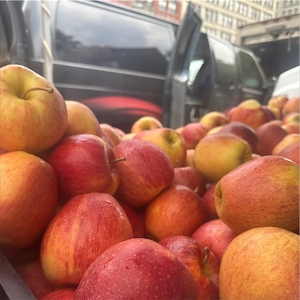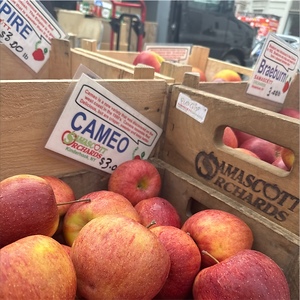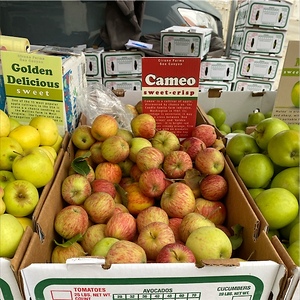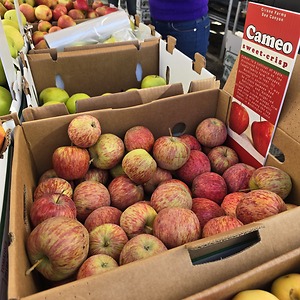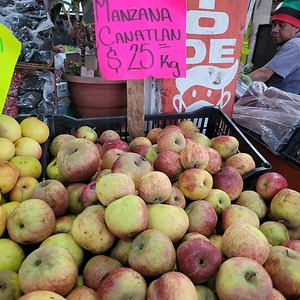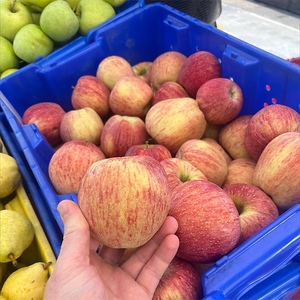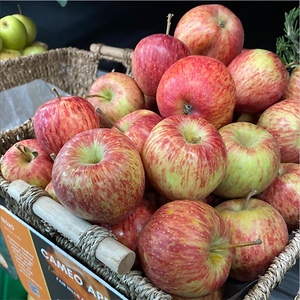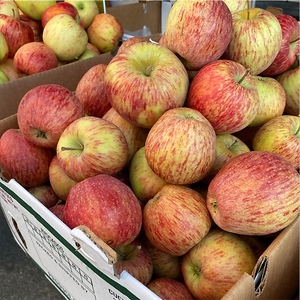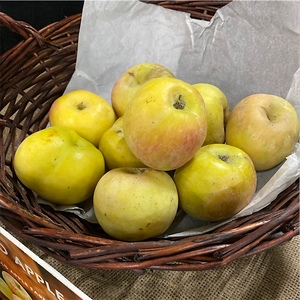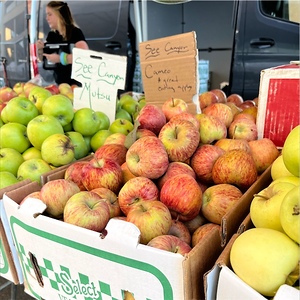

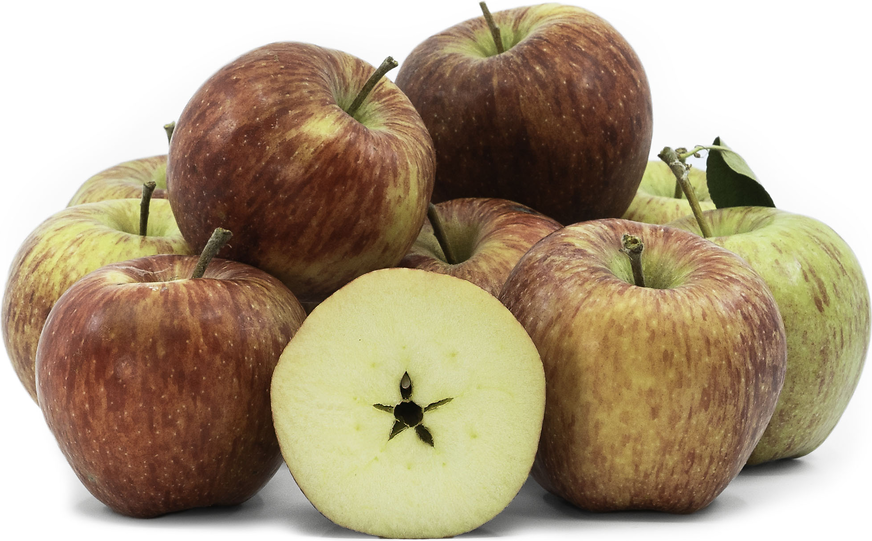
Cameo Apples
Estimated Inventory, 72 ct : 0
Description/Taste
Cameo apples are a medium to large varietal, averaging 7 to 8 centimeters in diameter, and have a round to conical shape, tapering slightly toward a flat base. The apples have an elongated, slender stem, averaging 3 to 4 centimeters in length, and the skin is moderately thick, tough, and smooth with a matte appearance. The fruits also bear a pale yellow-green base hue, covered in broken red striping that develops just before the apples are ready for harvest. It is important to note that the apples vary in appearance, depending on growing conditions, and some apples showcase yellow lenticels while others are entirely enveloped in a red flush. Underneath the surface, the ivory to white flesh is dense, aqueous, and firm with a crisp consistency. The flesh also encases a small central core filled with tiny black-brown, oval seeds. Cameo apples are aromatic and contain a somewhat balanced ratio of sugar to acid, creating a sweet, subtly tart flavor with honey, pears, and citrus nuances.
Seasons/Availability
Cameo apples are available late fall through early spring.
Current Facts
Cameo apples, botanically classified as Malus domestica, are a late-season American variety belonging to the Rosaceae family. The bi-colored apples were discovered as a chance seedling in Washington State in the late 20th century and grow on trees that can reach 3 to 4 meters in height. Cameo apples typically ripen 155 to 165 days after pollination and are a specialty variety grown for their unusual striping, crisp flesh, and sweet, subtly tart flavor. The apples also have a firm, dense nature, which allows them to be shipped long distances. This trait has led Cameo apples to be cultivated worldwide and exported as a lesser-known commercial apple. Cameo apples are versatile and can be incorporated into a wide array of beverages and fresh and cooked culinary preparations.
Nutritional Value
Cameo apples are a good source of fiber to regulate the digestive tract, vitamin C to strengthen the immune system while reducing inflammation, and potassium to balance fluid levels within the body. The apples also provide vitamin A to maintain healthy organ functioning, antioxidants to protect the cell against free radical damage, and contain other nutrients, including iron, magnesium, copper, zinc, vitamins E and K, and boron.
Applications
Cameo apples have a sweet, mildly tangy flavor well suited for fresh and cooked preparations. The fruits are most popularly consumed fresh, out of hand, and the flesh is slow to oxidize, allowing it to be used in salads, grain bowls, or parfaits. Cameo apples can also be served on cheese boards, layered into sandwiches for added crunch, used as a fresh topping over pancakes and waffles, or dipped in chocolate and nut butter as a snack. In addition to raw preparations, Cameo apples can be incorporated into sweet and savory cooked dishes. The apple’s naturally sweet flavor is enhanced with heating and is commonly used in apple sauces without the need for added sugar. The fruits can also be chopped and cooked into stuffing, polenta, and quiche, sauteed with spices and served with roasted meats, or sliced as a pizza topping. Beyond the apple’s flavor, its dense flesh holds well in cooking, creating a chunky filling for cobblers, crisps, pies, cakes, doughnuts, and tarts. The apples can also be stuffed with nuts and baked as a savory-sweet dessert or caramelized as a topping over ice cream. Cameo apples pair well with cheeses such as ricotta, goat, brie, and cheddar, herbs including parsley, rosemary, mint, and basil, squash, pears, spices such as cinnamon, cloves, nutmeg, allspice, and ginger, and meats including beef, pork, poultry, and turkey. Whole, unwashed Cameo apples will keep for several weeks to a month when stored in the refrigerator's crisper drawer.
Ethnic/Cultural Info
Cameo apples have become a favored fresh-eating variety throughout England. Despite its American roots, Cameo apples have been planted in apple orchards across England, especially in Kent, and are harvested from December to May. English growers highly favor the variety for its firm, crisp nature, sweet flavor, and extended storage capabilities, allowing for a longer sales season. Cameo apples also won several tasting competitions against English apple varieties at the National Fruit Show in Kent. This prestigious competition was once known as the Marden Fruit Show, established in 1933, and the first show drew 1,538 attendees. The National Fruit Show has been held annually for over 89 years, omitting years during the war, and the competition allows growers the opportunity to showcase their prized, locally cultivated fruit. The Queen has also made appearances at the show, increasing its popularity and prestige. In 2008 and 2009, Cameo apples beat out varieties such as cox’s orange pippin and gala apples in the Tastiest Apple award for two consecutive years.
Geography/History
Cameo apples were discovered growing as a chance seedling in an orchard in Dryden, a small community in the Wenatchee Valley of Washington State, in 1987. Darrel D. Caudle, with his wife Marilynn M. Caudle, noticed the striped apples growing in a field of red delicious apples and selected the unusual fruits as a new variety. The apples were originally named Caudle apples and later Carousel apples and were propagated using grafting and budding techniques for several generations. The parentage of Cameo apples is unknown, but the fruits were found on a red delicious tree with nearby golden delicious trees acting as pollinators. Cameo apples were released to commercial growers in the late 20th and early 21st centuries and were filed for a patent in 1993. The variety was granted a patent in 1995, but the patent recently expired in 2013 and was not renewed. Today Cameo apples are mainly grown in Washington State in the United States, with a few farms found across the nation in other apple-growing regions. The variety is also cultivated in Europe, New Zealand, Australia, South Africa, and Chile, where the fruits are sold domestically and exported to nearby countries. When in season, Cameo apples are sold through select retailers and distributors worldwide.
Recipe Ideas
Recipes that include Cameo Apples. One



